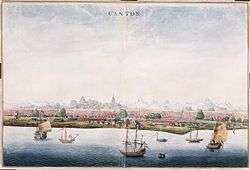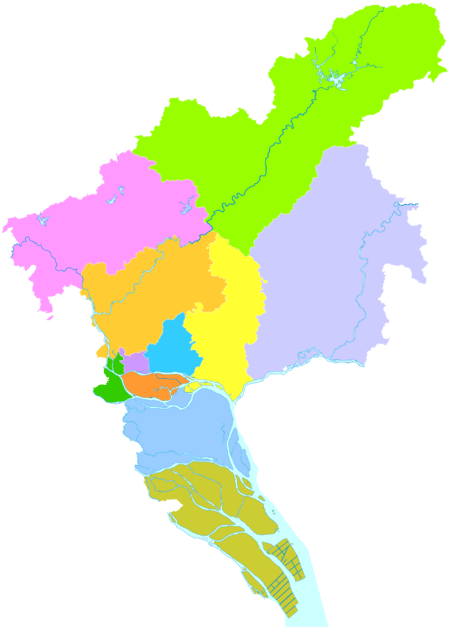Timeline of Guangzhou
The following is a timeline of the history of the Chinese city of Guangzhou, also formerly known as Panyu, Canton, and Kwang-chow.[1][2]
This is a dynamic list and may never be able to satisfy particular standards for completeness. You can help by expanding it with reliably sourced entries.
Nanyue
 | |||||||
|---|---|---|---|---|---|---|---|
| ANCIENT | |||||||
| Neolithic c. 8500 – c. 2070 BC | |||||||
| Xia dynasty c. 2070 – c. 1600 BC | |||||||
| Shang dynasty c. 1600 – c. 1046 BC | |||||||
| Zhou dynasty c. 1046 – 256 BC | |||||||
| Western Zhou | |||||||
| Eastern Zhou | |||||||
| Spring and Autumn | |||||||
| Warring States | |||||||
| IMPERIAL | |||||||
| Qin dynasty 221–206 BC | |||||||
| Han dynasty 206 BC – 220 AD | |||||||
| Western Han | |||||||
| Xin dynasty | |||||||
| Eastern Han | |||||||
| Three Kingdoms 220–280 | |||||||
| Wei, Shu and Wu | |||||||
| Jin dynasty 265–420 | |||||||
| Western Jin | |||||||
| Eastern Jin | Sixteen Kingdoms | ||||||
| Northern and Southern dynasties 420–589 | |||||||
| Sui dynasty 581–618 | |||||||
| Tang dynasty 618–907 | |||||||
| (Second Zhou dynasty 690–705) | |||||||
| Five Dynasties and Ten Kingdoms 907–960 |
Liao dynasty 907–1125 | ||||||
| Song dynasty 960–1279 |
|||||||
| Northern Song | Western Xia | ||||||
| Southern Song | Jin | ||||||
| Yuan dynasty 1271–1368 | |||||||
| Ming dynasty 1368–1644 | |||||||
| Qing dynasty 1644–1911 | |||||||
| MODERN | |||||||
| Republic of China 1912–1949 | |||||||
| People's Republic of China 1949–present |
Republic of China (Taiwan) 1949–present | ||||||
- 214 BCE – Panyu established as a Qin base during Zhao Tuo's first failed invasion of the southern lands of the Baiyue
- 204 BCE – Panyu becomes the capital of Zhao Tuo's kingdom of Nanyue.
Imperial China
- 111 BCE – Panyu becomes a provincial capital of the Han Dynasty after the Han–Nanyue War as the Han expands southward.
- 226 CE – Panyu becomes the seat of Guang Prefecture ("Guangzhou").
- 401 – Guangxiao Temple first established as the "Baoen Guangziao" Temple.[3]
- 537 – Temple of the Six Banyan Trees built.
- 1350 – Huaisheng Mosque rebuilt.[4]
- 1380 – Zhenhai Tower built.
- 1516 – Portuguese merchants arrive.[5]

View of Canton with merchant ship of the Dutch East India Company, c. 1665
- 1600 – Pazhou Pagoda built.
- 1619 – Chigang Pagoda built.
- 1684 – British East India Company in business.[6]

Painting of the Thirteen Factories c. 1820, with flags of Denmark, Spain, the U.S., Sweden, Britain, and the Netherlands
- 1821 – Xigutang literary society formed.[7]
- 1822 - Fire.[8]
- 1827 – The Canton Register, an English-language newspaper, begins publication.[9][10]
- 1832 – Jardine, Matheson and Co. in business.
- 1834 – Wetmore & Co. in business.[11]
- 1835 – The Canton Press, an English-language newspaper, begins publication.[9]
- 1840 – Augustine Heard and Company in business.[11]
- 1841
- February 27: Battle of First Bar.
- March 2: Battle of Whampoa.
- March 18: Battle of Canton
- May: Second Battle of Canton.
- 1842 – City designated a treaty port under the Treaty of Nanking.[6]
- 1848 – Apostolic Vicariate of Guangdong-Guangxi established.
- 1856
- British/French occupation begins.[6]
- Thirteen Factories set on fire.[11]
- 1859 – Shameen Island divided into French and British concessions.[6]
- 1861 – British/French occupation ends.[6]
- 1863 – Sacred Heart Cathedral built.
- 1866 – Yu Yin Shan Fang garden laid out.[12]
- 1879
- 1894
- Plague (3rd Pandemic).
- Chen Clan Academy built.
- 1908 – Guangzhou North Railway Station opens.
- 1911 – Kowloon–Canton Railway begins operating.
Republic of China
- 1918 – Urban council established.
- 1923
- June: National Congress of the Communist Party of China held in Guangzhou.[14]
- Kuomintang in power.[15]
- 1924
- 1927 – December 11–13: Communist uprising.[16]
- 1931 – Sun Yat-sen Memorial Hall built.
- 1932
- Guangzhou Baiyun Airport opens in Baiyun District.
- Guangzhou Conservatory of Music founded.
- 1933 – Haizhu Bridge constructed.
- 1936
- Canton–Hankou Railway begins operating.
- Population: 1,122,600 (estimate).[6]
- 1938 – October 21: Japanese occupation begins.[6]
- 1945 – September 16: Japanese occupation ends.[17]
- 1949
- Nationalist government under the acting president Li Zongren relocates to Guangzhou.
- Nanfang Daily newspaper begins publication.
People's Republic of China
- 1949
- October: Communist forces enter city.
- Radio Guangdong begins broadcasting.
- 1952 – Guangzhou Daily newspaper begins publication.
- 1954
- 1956 – Guangzhou University of Chinese Medicine founded.
- 1957
- Beijing–Guangzhou Railway in operation.
- Canton Fair begins.
- Guangzhou Symphony Orchestra founded.
- 1958
- Guangzhou Academy of Fine Arts in operation.
- Jinan University relocates to Guangzhou.
- 1959 – Guangdong Provincial Museum founded.
- 1964 – Population: 3,031,486.[19]
- 1967 – Renmin Bridge built.
- 1981 - Sister city relationship established with Los Angeles, USA.[20]
- 1982 – Guangzhou Library and Liyuan Poetry Society established.[21]
- 1983 – Mausoleum of the Nanyue King discovered.[22]
- 1984
- Guangzhou Economic and Technological Development Zone established.
- City designated sub-provincial city administrative status.
- Southern Weekly newspaper begins publication.
- 1985
- Zhujiang Brewery begins operation.
- Guangzhou Bridge built.
- 1988
- Haiyin Bridge built.
- Museum of the Mausoleum of the Nanyue King opens.
- 1990
- Guangdong International Building constructed.
- Avon begins hiring ladies in Guangzhou.[23]
- Population: 6,299,943.[24]
- 1991
- Guangzhou TV Tower erected.
- November: 1991 FIFA Women's World Cup held.
- 1992 – Guangzhou Free Trade Zone established.[25]
- 1996 – Guangzhou East Railway Station opens.
- 1997
- Guangzhou Metro begins operating.
- CITIC Plaza and Humen Pearl River Bridge built.
- Southern Metropolis Daily begins publication.
- Xiangjiang Safari Park opens.
- 1998 – Hedong Bridge, Jiangwan Bridge, Jiefang Bridge, and Huanan Bridge open.
- 2000 – Yajisha Bridge opens.
- 2001
- Guangdong Olympic Stadium opens.
- November: Chinese National Games held in Guangzhou.
- 2002
- 2003
- Zhang Guangning becomes mayor.
- Pazhou Bridge opens.
- 2004
- Guangzhou Baiyun International Airport opens in Huadu District.
- Guangzhou Higher Education Mega Center built.
- Guangzhou International Women's Open tennis tournament begins.
- 2006 – Chime-Long Paradise amusement park in business.
- 2008 – Huangpu Bridge and Xinguang Bridge open.
- 2009 – Liede Bridge opens.
- 2010
- Canton Tower and Guangzhou International Finance Center built.
- November: 2010 Asian Games held.
- Guangzhou Opera House, Guangdong Museum, and Guangzhou South Railway Station open.
- Wan Qingliang becomes mayor.
- Guangzhou Television Cantonese controversy.
- Guangzhou Bus Rapid Transit system launched.[27]
- 2011
- Guangzhou–Zhuhai Intercity Railway begins operating.
- Pearl River Tower built.
- Chen Jianhua becomes mayor.
- 2012 – Leatop Plaza and The Pinnacle built.
- 2013 - Air pollution in Guangzhou reaches annual mean of 48 PM2.5 and 72 PM10, more than recommended.[28]
See also
- Guangzhou history
- List of administrative divisions of Guangzhou
- Mayor of Guangzhou
- List of newspapers in Guangdong
- List of universities and colleges in Guangzhou
- List of historic buildings in Guangzhou
- List of tallest buildings in Guangzhou (sortable by date)
- Eight Sights of Guangzhou
- Major National Historical and Cultural Sites (Guangdong) in Guangzhou
- Southward expansion of the Han Dynasty
- Other names of Guangzhou
References
This article incorporates information from the Chinese Wikipedia, Dutch Wikipedia, and the Japanese Wikipedia.
Citations
- ↑ EB (1878), p. 37.
- ↑ EB (1911), p. 218.
- ↑ IDHP (1996).
- ↑ ArchNet.org. "Guangzhou". USA: MIT School of Architecture and Planning. Retrieved 14 March 2013.
- ↑ Szczesniak (1956).
- 1 2 3 4 5 6 7 Webster's (1960).
- ↑ Hiromasa (1986).
- ↑ Chronologies (1990), "Fires".
- 1 2 "Guangzhou Newspapers", WorldCat, Online Computer Library Center, retrieved 14 March 2013.
- ↑ Canton Register, Vol. VIII, 1835.
- 1 2 3 Farris (2007).
- ↑ Keswick (2003).
- 1 2 Lo & al. (1977).
- ↑ Dictionary of the CCP (2012), p. 15.
- ↑ Paulès (2009).
- ↑ Dirlik (1997).
- ↑ CCAHC (2000).
- ↑ "Garden Search: China". London: Botanic Gardens Conservation International. Retrieved 30 September 2015.
- ↑ "部分年份城乡人口分布", 广东省志:人口志, Local Records Office of Guangdong, retrieved 4 August 2011. (Chinese)
- ↑ "Sister Cities of Los Angeles". City of Los Angeles. Retrieved 30 December 2015.
- ↑ Lam (2007).
- ↑ "Guangzhou", China, Lonely Planet, retrieved 14 March 2013.
- ↑ Kristof, Nicholas (3 May 1992), "Guangzhou: Let a Thousand Lipsticks Bloom", New York Times.
- 1 2 广州市商业网点发展规划主报告(2003—2012) (PDF), Beijing: Department of Market System Development, Chinese Ministry of Commerce, retrieved 4 August 2011.
- ↑ UN (2005).
- ↑ "China". Art Spaces Directory. New York: New Museum. Retrieved 2 December 2013.
- ↑ Komanoff, Charles (15 March 2010), "Postcard From a Guangzhou Traffic Jam", New York Times.
- ↑ World Health Organization (2016), Global Urban Ambient Air Pollution Database, Geneva
Bibliography
See also: Bibliography of Guangzhou
- Columbia Chronologies of Asian History & Culture, Columbia University Press, 2000.
- "Canton", Encyclopædia Britannica, 9th ed., Vol. V, New York: Charles Scribner's Sons, 1878, pp. 37–39.
- "Canton", Encyclopædia Britannica, 11th ed., Vol. V, Cambridge: Cambridge University Press, 1911, pp. 218–220.
- Historical Dictionary of the Chinese Communist Party, Scarecrow Press, 2012, ISBN 978-0-8108-7225-7.
- International Dictionary of Historic Places: Asia and Oceania, Routledge, 1996, ISBN 9781884964046
- New York Public Library Book of Chronologies, New York: Prentice Hall, 1990, OL 1885709M.
- Webster's Geographical Dictionary, Springfield: G. & C. Merriam Co., 1960, OL 5812502M.
- Dirlik, Arif (1997), "Narrativizing Revolution: The Guangzhou Uprising (11-13 December 1927) in Workers' Perspective", Modern China, Vol. 23.
- Farris, Jonathan A. (2007), "Thirteen Factories of Canton: An Architecture of Sino-Western Collaboration and Confrontation", Buildings & Landscapes, Vol. 14.
- Hiromasa, Inoue (1986), "Wu Lanxiu and Society in Guangzhou on the Eve of the Opium War", Modern China, Vol. 12.
- Keswick, Maggie (2003), The Chinese Garden, Frances Lincoln Publishers, ISBN 9780711220317.
- Lam Lap (2007), "The Revival of Classical-Style Poetry Writing: A Field Study of Poetry Societies in Guangzhou", Chinese Literature: Essays, Articles, Reviews, Vol. 29.
- Lo Chor-Pang; et al. (1977), "Land Use Changes and City Planning in Shenyang and Canton", Geographical Review, Vol. 67.
- Paulès, Xavier (2009), "Opium in the City: A Spatial Study of Guangzhou's Opium Houses, 1923–1936", Modern China, Vol. 35.
- Szczesniak, Boleslaw (1956), "Pictorials of Contempt: A Note on the British in Mid-19th Century Canton", Monumenta Serica, Vol. 15.
- United Nations (2005), Free Trade Zone and Port Hinterland Development, United Nations Publications.
External links
| Wikimedia Commons has media related to Guangzhou. |
- Items related to Guangzhou and Canton, various dates (via Europeana).
- "(Works related to Guangzhou)". V&A Collections. London: Victoria and Albert Museum.
- Items related to Guangzhou and Canton, China, various dates (via Digital Public Library of America).
Coordinates: 23°08′00″N 113°16′00″E / 23.133333°N 113.266667°E
This article is issued from Wikipedia - version of the 12/2/2016. The text is available under the Creative Commons Attribution/Share Alike but additional terms may apply for the media files.
